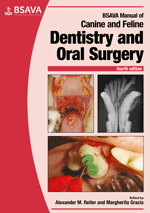
Full text loading...

A dental record is an essential part of the patient’s medical record, as it helps the veterinary surgeon to arrive at an accurate diagnosis and oral treatment plan. Complete with examples of dental/oral surgical charts, this chapter covers history-taking, medical examination, equipment, extraoral and intraoral examination, and assessment of various veterinary products.
Dental and oral examination and recording, Page 1 of 1
< Previous page | Next page > /docserver/preview/fulltext/10.22233/9781905319602/9781905319602.3-1.gif

Full text loading...













